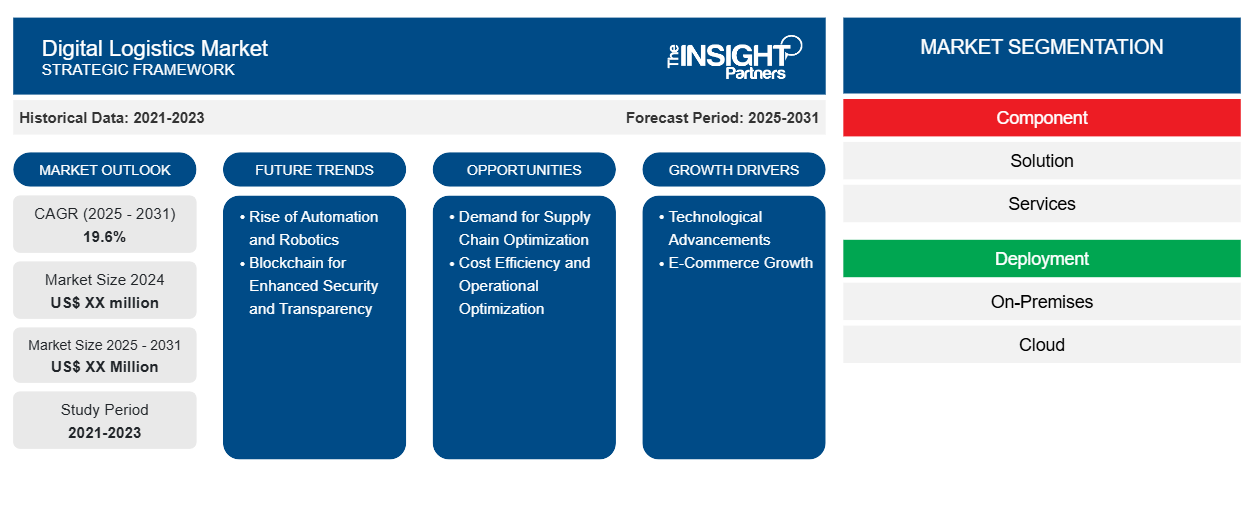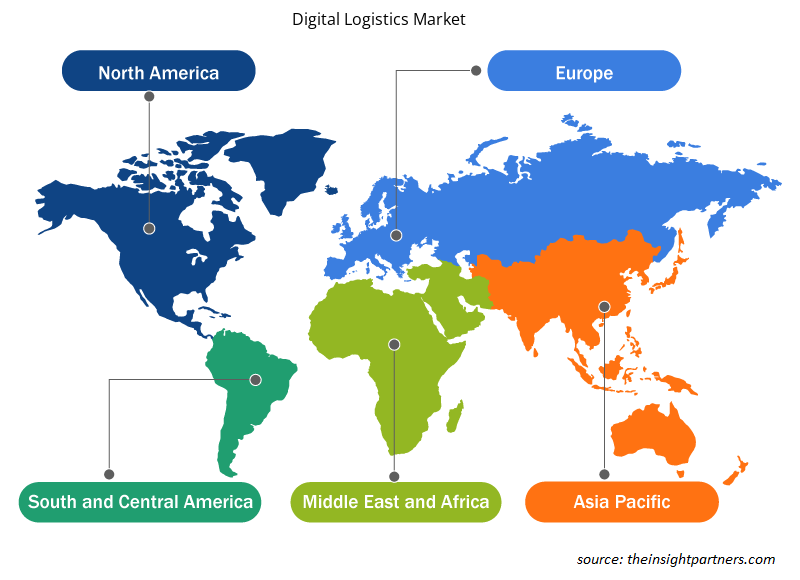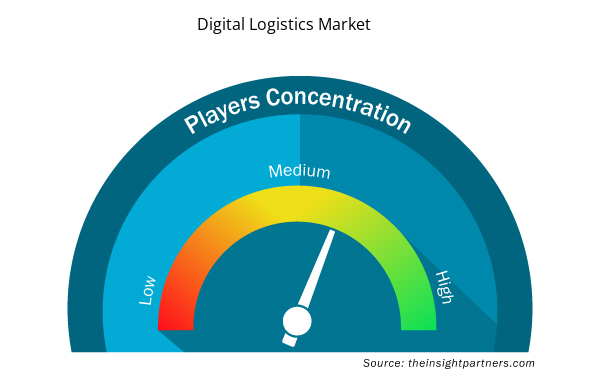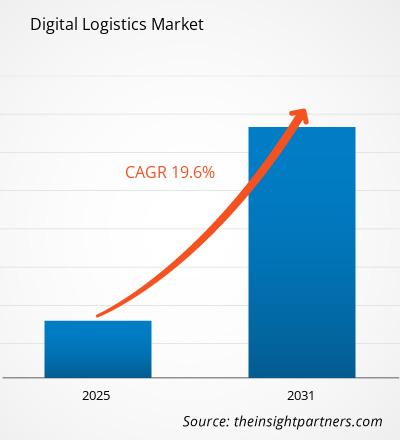デジタル物流市場は、2025年から2031年にかけて19.6%のCAGRで成長すると予想されており、市場規模は2024年のXX百万米ドルから2031年にはXX百万米ドルに拡大する見込みです。
レポートは、コンポーネント(ソリューション(資産管理、倉庫管理、車両管理、データ管理と分析、その他)とサービス)、展開(オンプレミス、クラウド)、企業規模(大企業、中小企業)、アプリケーション(輸送管理、倉庫管理、労務管理、その他)、エンドユーザー業界(製造、小売および消費財、ヘルスケア、エネルギーと公共事業、自動車、その他)別にセグメント化されています。グローバル分析は、地域レベルと主要国でさらに細分化されています。レポートは、上記の分析とセグメントに対して米ドルでの価値を提供します。
報告書の目的
The Insight Partners のレポート「デジタル物流市場」は、現在の状況と将来の成長、主な推進要因、課題、機会を説明することを目的としています。これにより、次のようなさまざまなビジネス関係者に洞察が提供されます。
- テクノロジープロバイダー/メーカー: 進化する市場の動向を理解し、潜在的な成長機会を把握することで、情報に基づいた戦略的意思決定が可能になります。
- 投資家: 市場の成長率、市場の財務予測、バリュー チェーン全体に存在する機会に関する包括的な傾向分析を実施します。
- 規制機関: 市場の乱用を最小限に抑え、投資家の信用と信頼を維持し、市場の完全性と安定性を維持することを目的として、市場における政策と警察活動を規制します。
デジタル物流市場のセグメンテーション
成分
- 解決
- サービス
展開
- オンプレミス
- 雲
企業規模
- 大企業
- 中小企業
応用
- 輸送管理
- 倉庫管理
- 労務管理
- その他
エンドユーザー業界
- 製造業
- 小売・消費財
- 健康管理
- エネルギーと公共事業
- 自動車
- その他
要件に合わせてレポートをカスタマイズする
このレポートの一部、国レベルの分析、Excelデータパックなど、あらゆるレポートを無料でカスタマイズできます。また、スタートアップや大学向けのお得なオファーや割引もご利用いただけます。
デジタル物流市場:戦略的洞察

- このレポートの主要な市場動向を入手してください。この無料サンプルには、市場動向から見積もりや予測に至るまでのデータ分析が含まれます。
デジタル物流市場の成長要因
- 技術の進歩: 技術の進歩は、デジタル物流市場の最大の推進力の 1 つです。モノのインターネット、ビッグ データ分析、AI、機械学習の統合により、可視性の向上、情報に基づいた意思決定、ルーティングの最適化を通じて、物流業界が合理化されています。たとえば、IoT 対応ソリューションでは、出荷をリアルタイムで追跡し、出荷の位置と状態に関する最新情報をリアルタイムで提供できます。一方、人工知能と機械学習アルゴリズムは、物流会社が需要を予測し、サプライ チェーンを最適化し、予測精度を向上させ、運用コストを削減して効率を高めるのに役立ちます。
- 電子商取引の成長: 電子商取引分野の驚異的な成長は、デジタル物流市場の強力な推進力の 1 つです。オンライン購入が引き続き増加傾向にあるため、より高速で効率的な物流ソリューションの必要性も同様に比例して高まっています。今日の消費者は、より迅速な配達、リアルタイムの追跡、これまで以上に高い透明性を期待しています。消費者のこのような期待に応えるため、電子商取引業界では、注文処理の高速化、ラストマイルの配達の最適化、リードタイムの最小化を実現するために、デジタル物流ソリューションの採用がますます増えています。これにより、物流会社は、増加する注文量を管理し、複雑な物流プロセスをより効率的に実行できるデジタル プラットフォームを利用できる機会を得ています。
デジタル物流市場の将来動向
- 自動化とロボットの台頭: 物流業界では、効率性を高め、人手不足を解消しながら人件費を節約するという目標を掲げ、自動化とロボットの導入が進んでいます。ロボットが仕分け、梱包、在庫管理を担当する自動倉庫が普及しつつあります。さらに、ドローンや自動運転トラックなどの自律型配送車両が現在、さまざまな市場でテストされ、導入されています。これらの技術は、業務効率を高めるだけでなく、人為的ミスの可能性を軽減し、安全性を高め、スループットを向上させます。自動化が普及するにつれ、デジタル物流企業がこれらの技術を自社のサービスに導入する大きなチャンスが生まれます。
- セキュリティと透明性を強化するブロックチェーン: ブロックチェーン技術は、特にサプライ チェーンの透明性とセキュリティの向上において、デジタル ロジスティクスの大きなトレンドになりつつあります。ブロックチェーンは、商品の真正性を保証し、商品を原産地から配送まで追跡し、サプライ チェーンにおける不正を防止する、分散型の不変の台帳を提供します。ブロックチェーンを実装することで、ロジスティクス プロバイダーは顧客に出荷品の安全でリアルタイムの追跡と検証を提供できます。この技術は、企業がロジスティクス プロセスにおける信頼性と透明性を高めるのに役立ち、セキュリティと真正性が極めて重要な医薬品、高級品、食品などの業界にとって魅力的なソリューションとなっています。
デジタル物流市場の機会
- サプライ チェーン最適化の需要: グローバル サプライ チェーンは、多数のタッチポイント、国際出荷、および変動する需要パターンにより、ますます複雑化しており、組織はサプライ チェーンの完全な可視性とリアルタイム管理を可能にするデジタル ロジスティクス ソリューションをますます導入する必要が生じています。現代のビジネス運営では、クラウドベースのソフトウェア プラットフォーム、データ分析、およびデジタル ツイン (サプライ チェーンの仮想モデルとして定義) などのツールにより、組織は在庫を細かく追跡し、ルートを最適化し、倉庫を管理し、ロジスティクス プロセス内の非効率性を削減できます。よりインテリジェントで相互接続されたサプライ チェーンに対する需要の高まりにより、デジタル ロジスティクス プロバイダーが包括的なデータ主導のソリューションを提供する大きな機会が生まれています。
- コスト効率と運用の最適化: コスト効率と運用の最適化。これらのデジタル ロジスティクス ソリューションにより、企業はコストを削減しながら効率とパフォーマンスを一段と高めることができます。在庫管理、注文処理、配送スケジュールなどのタスクを自動化することで、人件費と運用の非効率性を大幅に削減できます。さらに、この分析により、サプライ チェーンのボトルネックを追跡できるため、企業は情報に基づいた選択を行い、プロセスの遅延やリソースの無駄を減らすことができます。物流企業は経費を削減し、利益率を上げるようますます圧力を受けており、物流業務の効率化に役立つデジタル ソリューションの需要が急増するでしょう。
デジタル物流市場の地域別分析
予測期間を通じてデジタル物流市場に影響を与える地域的な傾向と要因は、Insight Partners のアナリストによって徹底的に説明されています。このセクションでは、北米、ヨーロッパ、アジア太平洋、中東、アフリカ、南米、中米にわたるデジタル物流市場のセグメントと地理についても説明します。

- デジタル物流市場の地域別データを入手
デジタル物流市場レポートの範囲
| レポート属性 | 詳細 |
|---|---|
| 2024年の市場規模 | XX百万米ドル |
| 2031年までの市場規模 | XX百万米ドル |
| 世界のCAGR(2025年~2031年) | 19.6% |
| 履歴データ | 2021-2023 |
| 予測期間 | 2025-2031 |
| 対象セグメント | コンポーネント別
|
| 対象地域と国 | 北米
|
| 市場リーダーと主要企業プロフィール |
|
デジタル物流市場のプレーヤー密度:ビジネスダイナミクスへの影響を理解する
デジタル物流市場は、消費者の嗜好の変化、技術の進歩、製品の利点に対する認識の高まりなどの要因により、エンドユーザーの需要が高まり、急速に成長しています。需要が高まるにつれて、企業は提供を拡大し、消費者のニーズを満たすために革新し、新たなトレンドを活用し、市場の成長をさらに促進しています。
市場プレーヤー密度とは、特定の市場または業界内で活動している企業または会社の分布を指します。これは、特定の市場スペースに、その規模または総市場価値と比較して、どれだけの競合相手 (市場プレーヤー) が存在するかを示します。
デジタル物流市場で事業を展開している主要企業は次のとおりです。
- ウェブエクスプレス
- IBMコーポレーション
- テックマヒンドラリミテッド
- インフォシス・リミテッド
- HCLテクノロジーズリミテッド
- AT&T 知的財産
免責事項:上記の企業は、特定の順序でランク付けされていません。

- デジタル物流市場のトップキープレーヤーの概要を入手
主なセールスポイント
- 包括的なカバレッジ: レポートでは、デジタル物流市場の製品、サービス、タイプ、エンドユーザーの分析を包括的にカバーし、全体的な展望を提供します。
- 専門家による分析: レポートは、業界の専門家とアナリストの深い理解に基づいてまとめられています。
- 最新情報: このレポートは、最新の情報とデータの傾向を網羅しているため、ビジネスの関連性を保証します。
- カスタマイズ オプション: このレポートは、特定のクライアント要件に対応し、ビジネス戦略に適切に適合するようにカスタマイズできます。
したがって、デジタル物流市場に関する調査レポートは、業界のシナリオと成長の見通しを解読し理解する道の先導役となる可能性があります。正当な懸念事項がいくつかあるかもしれませんが、このレポートの全体的な利点は欠点を上回る傾向があります。
- 過去2年間の分析、基準年、CAGRによる予測(7年間)
- PEST分析とSWOT分析
- 市場規模価値/数量 - 世界、地域、国
- 業界と競争環境
- Excel データセット


- Environmental Consulting Service Market
- Resistance Bands Market
- Fixed-Base Operator Market
- Microcatheters Market
- Rare Neurological Disease Treatment Market
- Electronic Signature Software Market
- Foot Orthotic Insoles Market
- Terahertz Technology Market
- Educational Furniture Market
- Online Exam Proctoring Market

Report Coverage
Revenue forecast, Company Analysis, Industry landscape, Growth factors, and Trends

Segment Covered
This text is related
to segments covered.

Regional Scope
North America, Europe, Asia Pacific, Middle East & Africa, South & Central America

Country Scope
This text is related
to country scope.
よくある質問
Rise of Automation and Robotics is anticipated to play a significant role in the global digital logistics market in the coming years
The report can be delivered in PDF/PPT format; we can also share excel dataset based on the request
Some of the customization options available based on the request are an additional 3-5 company profiles and country-specific analysis of 3-5 countries of your choice. Customizations are to be requested/discussed before making final order confirmation as our team would review the same and check the feasibility
The major factors driving the digital logistics market are:
1. Technological Advancements
2. E-Commerce Growth
The Digital Logistics Market is estimated to witness a CAGR of 19.6% from 2023 to 2031
Trends and growth analysis reports related to Technology, Media and Telecommunications : READ MORE..
The List of Companies
1. Accenture
2. Advantech Co., Ltd.
3. DigiLogistics Technology Ltd.
4. Hexaware Technologies Limited
5. IBM Corporation
6. Oracle
7. Samsung
8. SAP SE
9. Siemens Digital Logistics GmbH
10. Tech Mahindra Limited
The Insight Partners performs research in 4 major stages: Data Collection & Secondary Research, Primary Research, Data Analysis and Data Triangulation & Final Review.
- Data Collection and Secondary Research:
As a market research and consulting firm operating from a decade, we have published and advised several client across the globe. First step for any study will start with an assessment of currently available data and insights from existing reports. Further, historical and current market information is collected from Investor Presentations, Annual Reports, SEC Filings, etc., and other information related to company’s performance and market positioning are gathered from Paid Databases (Factiva, Hoovers, and Reuters) and various other publications available in public domain.
Several associations trade associates, technical forums, institutes, societies and organization are accessed to gain technical as well as market related insights through their publications such as research papers, blogs and press releases related to the studies are referred to get cues about the market. Further, white papers, journals, magazines, and other news articles published in last 3 years are scrutinized and analyzed to understand the current market trends.
- Primary Research:
The primarily interview analysis comprise of data obtained from industry participants interview and answers to survey questions gathered by in-house primary team.
For primary research, interviews are conducted with industry experts/CEOs/Marketing Managers/VPs/Subject Matter Experts from both demand and supply side to get a 360-degree view of the market. The primary team conducts several interviews based on the complexity of the markets to understand the various market trends and dynamics which makes research more credible and precise.
A typical research interview fulfils the following functions:
- Provides first-hand information on the market size, market trends, growth trends, competitive landscape, and outlook
- Validates and strengthens in-house secondary research findings
- Develops the analysis team’s expertise and market understanding
Primary research involves email interactions and telephone interviews for each market, category, segment, and sub-segment across geographies. The participants who typically take part in such a process include, but are not limited to:
- Industry participants: VPs, business development managers, market intelligence managers and national sales managers
- Outside experts: Valuation experts, research analysts and key opinion leaders specializing in the electronics and semiconductor industry.
Below is the breakup of our primary respondents by company, designation, and region:

Once we receive the confirmation from primary research sources or primary respondents, we finalize the base year market estimation and forecast the data as per the macroeconomic and microeconomic factors assessed during data collection.
- Data Analysis:
Once data is validated through both secondary as well as primary respondents, we finalize the market estimations by hypothesis formulation and factor analysis at regional and country level.
- Macro-Economic Factor Analysis:
We analyse macroeconomic indicators such the gross domestic product (GDP), increase in the demand for goods and services across industries, technological advancement, regional economic growth, governmental policies, the influence of COVID-19, PEST analysis, and other aspects. This analysis aids in setting benchmarks for various nations/regions and approximating market splits. Additionally, the general trend of the aforementioned components aid in determining the market's development possibilities.
- Country Level Data:
Various factors that are especially aligned to the country are taken into account to determine the market size for a certain area and country, including the presence of vendors, such as headquarters and offices, the country's GDP, demand patterns, and industry growth. To comprehend the market dynamics for the nation, a number of growth variables, inhibitors, application areas, and current market trends are researched. The aforementioned elements aid in determining the country's overall market's growth potential.
- Company Profile:
The “Table of Contents” is formulated by listing and analyzing more than 25 - 30 companies operating in the market ecosystem across geographies. However, we profile only 10 companies as a standard practice in our syndicate reports. These 10 companies comprise leading, emerging, and regional players. Nonetheless, our analysis is not restricted to the 10 listed companies, we also analyze other companies present in the market to develop a holistic view and understand the prevailing trends. The “Company Profiles” section in the report covers key facts, business description, products & services, financial information, SWOT analysis, and key developments. The financial information presented is extracted from the annual reports and official documents of the publicly listed companies. Upon collecting the information for the sections of respective companies, we verify them via various primary sources and then compile the data in respective company profiles. The company level information helps us in deriving the base number as well as in forecasting the market size.
- Developing Base Number:
Aggregation of sales statistics (2020-2022) and macro-economic factor, and other secondary and primary research insights are utilized to arrive at base number and related market shares for 2022. The data gaps are identified in this step and relevant market data is analyzed, collected from paid primary interviews or databases. On finalizing the base year market size, forecasts are developed on the basis of macro-economic, industry and market growth factors and company level analysis.
- Data Triangulation and Final Review:
The market findings and base year market size calculations are validated from supply as well as demand side. Demand side validations are based on macro-economic factor analysis and benchmarks for respective regions and countries. In case of supply side validations, revenues of major companies are estimated (in case not available) based on industry benchmark, approximate number of employees, product portfolio, and primary interviews revenues are gathered. Further revenue from target product/service segment is assessed to avoid overshooting of market statistics. In case of heavy deviations between supply and demand side values, all thes steps are repeated to achieve synchronization.
We follow an iterative model, wherein we share our research findings with Subject Matter Experts (SME’s) and Key Opinion Leaders (KOLs) until consensus view of the market is not formulated – this model negates any drastic deviation in the opinions of experts. Only validated and universally acceptable research findings are quoted in our reports.
We have important check points that we use to validate our research findings – which we call – data triangulation, where we validate the information, we generate from secondary sources with primary interviews and then we re-validate with our internal data bases and Subject matter experts. This comprehensive model enables us to deliver high quality, reliable data in shortest possible time.

 このレポートの無料サンプルを入手する
このレポートの無料サンプルを入手する